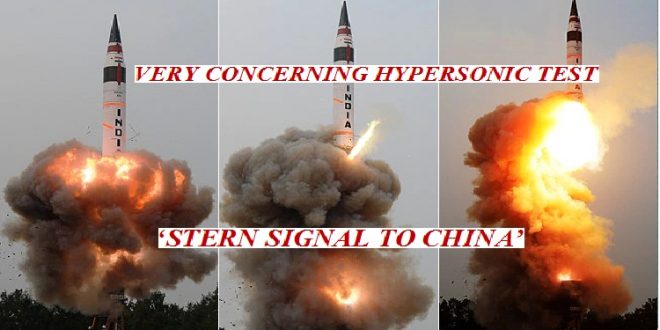29-10-2021
Bureau Report + Agencies
NEW DELHI/ BEIJING/ WASHINGTON/ ISLAMABAD: India has tested a ballistic missile capable of carrying a nuclear warhead up to 5,000 kilometres (3,100 miles), the defence ministry said, in what media called a “stern signal” to China as the two remain locked in a border spat.
 The Agni-5 missile blasted off from Abdul Kalam Island off India’s east coast late Wednesday and splashed into the Bay of Bengal.
The Agni-5 missile blasted off from Abdul Kalam Island off India’s east coast late Wednesday and splashed into the Bay of Bengal.
“The successful test … is in line with India’s stated policy to have ‘credible minimum deterrence’ that underpins the commitment to ‘No First Use’ [of nuclear weapons],” a defence ministry statement said.
The 17-metre-tall missile has been tested several times before, but not at night, and local media said that the timing was aimed at sending a signal to Beijing.
Tensions with China have been running high since 20 Indian soldiers died in clashes on their disputed Himalayas border in June 2020.
The nuclear-armed neighbours have since reinforced the frontier with tens of thousands of extra troops.
India has deepened defence cooperation with Western countries in recent years, including in the Quad alliance with the United States, Japan and Australia.
 New Delhi is also a major buyer of Russian military hardware, and ordered Moscow’s S-400 missile defence system despite the threat of US sanctions over the $5.4 billion deal.
New Delhi is also a major buyer of Russian military hardware, and ordered Moscow’s S-400 missile defence system despite the threat of US sanctions over the $5.4 billion deal.
The Financial Times reported this month that China had tested a hypersonic missile that circled the Earth at low orbit before descending toward, but missing, its target.
Beijing denied the report, insisting it was a routine test of a reusable space vehicle.
Hypersonics are the new frontier in missile technology, because they fly lower and are harder to detect than ballistic missiles, can reach targets more quickly, and are manoeuvrable.
The United States, Russia, China and North Korea have all tested hypersonic missiles and several others are developing the technology — including reportedly India.
According to the Times of India, New Delhi is working on enabling the Agni-5 to carry several nuclear warheads at once so they can split up and hit different targets.
 The top US military officer, General Mark Milley, has provided the first official US confirmation of a Chinese hypersonic weapons test that military experts say appears to show Beijing’s pursuit of an Earth-orbiting system designed to evade American missile defences.
The top US military officer, General Mark Milley, has provided the first official US confirmation of a Chinese hypersonic weapons test that military experts say appears to show Beijing’s pursuit of an Earth-orbiting system designed to evade American missile defences.
The Pentagon has been at pains to avoid direct confirmation of the Chinese test this summer, first reported by the Financial Times, even as President Joe Biden and other officials have expressed general concerns about Chinese hypersonic weapons development but Milley explicitly confirmed a test and said that it was “very close” to a Sputnik momen referring Russia’s 1957 launch of the first man-made satellite, which put Moscow ahead in the Cold War-era space race.
“What we saw was a very significant event of a test of a hypersonic weapon system. And it is very concerning,” Milley, chairman of the Joint Chiefs of Staff, told Bloomberg television, in an interview aired on Wednesday.
Nuclear arms experts say China’s weapons test appeared to be designed to evade US defences in two ways. First, hypersonics move at speeds of more than five times the speed of sound, or  about 6,200 kph (3,853 mph), making them harder to detect and intercept.
about 6,200 kph (3,853 mph), making them harder to detect and intercept.
Second, sources told Reuters that the United States believes China’s test involved a weapon that first orbited the Earth. That’s something military experts say is a Cold War concept known as “fractional orbital bombardment.”
Last month, Air Force Secretary Frank Kendall alluded to his concerns about such a system, telling reporters about a weapon that would go into an orbit and then descend on a target.
“If you use that kind of an approach, you don’t have to use a traditional ICBM trajectory which is directly from the point of launch to the point of impact,” he said.
“It’s a way to avoid defences and missile warning systems.”
Fractional Orbital Bombardment would also be a way for China to avoid US missile defences in Alaska, which are designed to combat a limited number of weapons from a country like North Korea.
 Jeffrey Lewis at the Middlebury Institute of International Studies summed up fractional orbital bombardment this way: “The simplest way to think about China’s orbital bombardment system is to imagine a space shuttle, put a nuclear weapon into the cargo bay, and forget about the landing gear.”
Jeffrey Lewis at the Middlebury Institute of International Studies summed up fractional orbital bombardment this way: “The simplest way to think about China’s orbital bombardment system is to imagine a space shuttle, put a nuclear weapon into the cargo bay, and forget about the landing gear.”
Lewis said the difference is that the Chinese re-entry system is a glider.
China’s foreign ministry denied a weapons test. It said it had carried out a routine test in July, but added: “It was not a missile, it was a space vehicle.”
US defences are not capable of combating a large-scale attack from China or Russia, which could overwhelm the system. But the open US pursuit of more and more advanced missile defences has led Moscow and Beijing to examine ways to defeat them, experts say, including hypersonics and, apparently, fractional orbital bombardment.
 Pressmediaofindia
Pressmediaofindia




